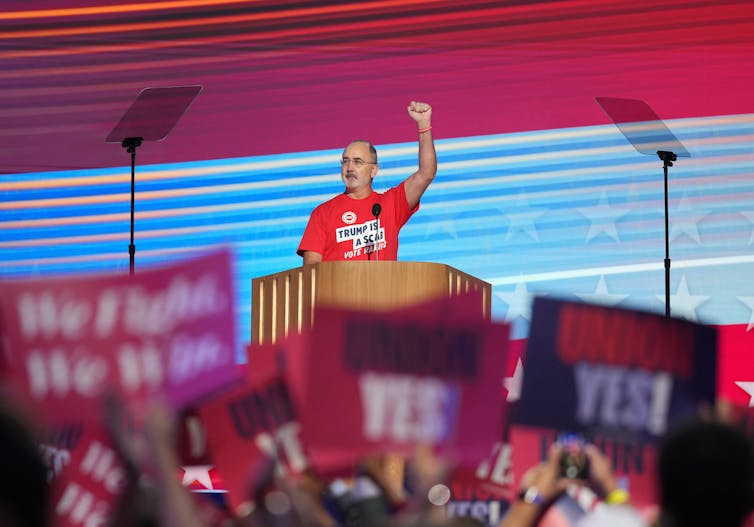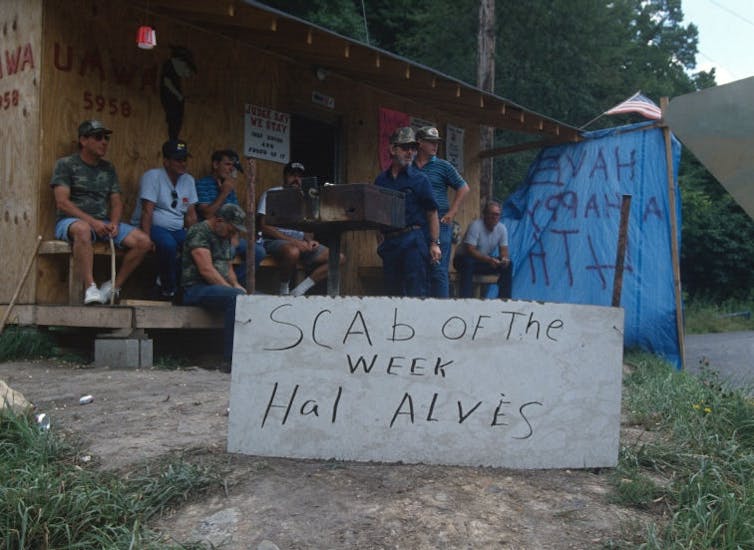What we’re seeing is a removing of cooling that’s revealing warming that’s already there. So the air pollution isn’t the cause of the warming. It’s just letting us see stuff that we’ve already done.Listen to the interview on The Conversation Weekly podcast. You can also read an article by Laura Wilcox and her colleague Bjørn H. Samset about their recent research on The Conversation. This episode of The Conversation Weekly was written and produced by Mend Mariwany, Gemma Ware and Katie Flood. Mixing by Michelle Macklem and theme music by Neeta Sarl. Newsclips in this episode from Voice of America, CBC, AP Archive, ABC (News) Australia, WFLA NBC Channel 8 and PBS. Listen to The Conversation Weekly via any of the apps listed above, download it directly via our RSS feed or find out how else to listen here. A transcript of this episode is available via the Apple Podcasts or Spotify apps.
News
How organized labor shames its traitors − the story of the ‘scab’
The term “scab” has historically been used to shame workers who betray labor solidarity. Its implications highlight complex issues of class, race, and ethical labor practices.

Ian Afflerbach, University of North Georgia
Over its long history, the American labor movement has displayed a remarkably rich vocabulary for shaming those deemed traitors to its cause.
Some insults, such as “blackleg,” are largely forgotten today. Others, such as “stool pigeon,” now sound more like the dated banter of film noir. A few terms still offer interesting windows into the past: “Fink,” for example, was used to disparage workers who informed for management; it seems to have been derived from “Pinkerton,” the private detective agency notorious for strikebreaking during mass actions like the Great Railroad Strike of 1877.
No word, however, has burned American workers more consistently, or more wickedly, than “scab.”
Any labor action today will inevitably lead to someone getting called a scab, an insult used to smear people who cross picket lines, break up strikes or refuse to join a union. No one is beyond the reach of this accusation: United Auto Workers President Shawn Fain called former president Donald Trump a “scab” in August 2024, after Trump suggested to Elon Musk that striking workers at one of Musk’s companies ought to be illegally fired.
While working on my book “Sellouts! The Story of an American Insult,” I discovered that labor’s scabs were among the first Americans identified as sellouts for betraying their own.
Reinforcing class solidarity
The use of scab as an insult actually dates to Medieval Europe. Back then, scabbed or diseased skin was widely seen as the sign of a corrupt or immoral character. So, English writers started using “scab” as slang for a scoundrel.
In the 19th century, American workers started using the word to attack peers who refused to join a union or worked when others were striking. By the 1880s, periodicals, union pamphlets and books all regularly used the epithet to chastise any workers or labor leaders who cooperated with bosses. Names of scabs were often printed in local papers.
Scab likely caught on because it directed visceral disgust at anyone who put self-interest above class solidarity.
Many of labor’s scabs clearly deserved the label. During a strike of Boston railroad workers in 1887, for instance, the union bombarded its chairman with cries of “traitor” and “scab” and “selling out,” because he gave in to company demands prematurely, just as the union’s funds were also mysteriously depleted.
The most powerful expression of this shame comes from the pen of Jack London. Best remembered today for adventure tales such as “White Fang,” London was also a socialist. His popular 1915 missive “Ode to a Scab” captures the venomous contempt many have felt about those who betray their fellow workers:
“After God had finished the rattlesnake, the toad, and the vampire, He had some awful substance left with which He made a scab… a two-legged animal with a corkscrew soul… Where others have hearts, he carries a tumor of rotten principles… No man has a right to scab as long as there is a pool of water deep enough to drown his body in.”
In 1904, however, London had written a longer and less famous essay, “The Scab.” Instead of shaming scabs, this essay explains the conditions that drive some workers to betray their own.
“The capitalist and labor groups,” London writes, “are locked together in a desperate battle,” with capital trying to ensure profits and labor trying to ensure a basic standard of living. A scab, he explains, “takes from [his peers’] food and shelter” by working when they will not. “He does not scab because he wants to scab,” London insists, but because he “cannot get work on the same terms.”
Rather than treat scabs as vampire-like traitors, London asks his readers to see scabbing as a moral transgression driven by competition. It is tempting to imagine society as “divided into the two classes of the scabs and the non-scabs,” London concludes, but in capitalism’s “social jungle, everybody is preying upon everybody else.”
Driven to scab
London’s words ring with a harsh truth, and we can illustrate his point by looking at the discomforting status of Black strikebreakers in American labor history.
During their heyday from the 1880s through the 1930s, major labor organizations such as the Knights of Labor and American Federation of Labor did include some Black workers and at times preached inclusion. These same groups, however, also tolerated openly racist behavior by local branches.
Historian Philip S. Foner tells the story of Robert Rhodes, a union bricklayer in Indiana whose “white union brothers refused to work with him.” The Bricklayers and Masons International Union of America did have a fine of US$100 for such discriminatory practices, but Rhodes was stymied in efforts to get any money, and his racist co-workers punished him for trying. He ended up being accused of “scabbing” by the union, and, in a brutal irony, fined. Rhodes quit and changed his career.
Civil rights activist W.E.B. Du Bois once noted that among the major working-class trades in America only longshoremen and miners welcomed Black workers. In most fields, they had to try to join unions that were often implicitly – if not explicitly – segregated.
To find work as masons, carpenters, coopers – or any other skilled trades dominated by unions that would often discriminate based on race – Black laborers often had to work under conditions that others would not tolerate: offering their services outside the union, or taking over work the union had done while its members were striking.
In short, they had to scab.
Class and race collide
It shouldn’t be hard to see the competing moral claims here. Black workers who had struggled with racial discrimination claimed an equal right to work, even if this meant disrupting a strike. Unions saw this as a violation of working-class solidarity, even as they overlooked discrimination within their ranks.
Managers and corporations, meanwhile, exploited this racial friction to weaken the labor movement. With tensions high, brawls often broke out between Black strikebreakers and white strikers. An account of the 1904 Chicago miners’ strike noted, “some one in the crowd yelled ‘scab,’ and instantly a rush was made for the negroes,” who fought back the mob with knives and pistols before city police intervened.
As this ugly pattern repeated itself, a stigma began to cling to Black workers. White laborers and their representatives, including American Federation of Labor founder Samuel Gompers, often called Black people a “scab race.”

In reality, Black workers were just a small percentage of strikebreakers. Most often, strikebreakers were white immigrants, who, like their Black counterparts, could face discrimination by unions. Black Americans also had a long history of labor activism, struggling for union membership, improved working conditions and better wages in cities such as New Orleans and Birmingham.
In his 1913 essay “The Negro and the Labor Unions,” educator Booker T. Washington urged unions to end their discriminatory practices, which forced Black Americans into becoming “a race of strike-breakers.” Nonetheless, this racial stigma persisted. Horrendous racial violence in the “Red Summer” of 1919 followed close on the heels of the Great Steel Strike, during which nonunion Black workers had been called in to keep steel production humming along.
Preventing fissures among workers
While terms like “scab” and “sellout” have often been used to reinforce labor unity, these same terms have also worsened divisions within the movement.
It’s too reductive, then, to simply shame scabs as sellouts. It’s important to understand why people might be motivated to weather scorn, rejection and even violence from their peers – and to take steps toward removing that motive.
In 2024, Canada’s Parliament passed landmark “anti-scab” legislation, which prohibits 20,000 employers from bringing in replacement workers during a strike.
This law will not only force companies to listen to their workers’ needs during a time of crisis, it will also create fewer divisions within the labor movement – and fewer opportunities for any worker to become a scab.
Ian Afflerbach, Associate Professor of American Literature, University of North Georgia
This article is republished from The Conversation under a Creative Commons license. Read the original article.
The Bridge is a section of the STM Daily News Blog meant for diversity, offering real news stories about bona fide community efforts to perpetuate a greater good. The purpose of The Bridge is to connect the divides that separate us, fostering understanding and empathy among different groups. By highlighting positive initiatives and inspirational actions, The Bridge aims to create a sense of unity and shared purpose. This section brings to light stories of individuals and organizations working tirelessly to promote inclusivity, equality, and mutual respect. Through these narratives, readers are encouraged to appreciate the richness of diverse perspectives and to participate actively in building stronger, more cohesive communities.
https://stmdailynews.com/the-bridge
Discover more from Daily News
Subscribe to get the latest posts sent to your email.
Blog
The Wild, Wacky Legacy of Pasadena’s Doo Dah Parade
Discover the bizarre and beloved history of Pasadena’s Doo Dah Parade — the irreverent, comedic, anything-goes counter-parade that became a Southern California cultural icon.
The Wild, Wacky Legacy of Pasadena’s Doo Dah Parade
For nearly four decades, Pasadena’s Doo Dah Parade turned the idea of a “traditional” parade on its head — then stomped on it with lawn-chair drill teams, absurd costumes, and satire that could lampoon anything from politics to pop culture to the Rose Parade itself. What began as a joke in a Pasadena bar became one of Southern California’s most iconic community celebrations of imagination, humor, and glorious weirdness.
From Barroom Idea to Cultural Phenomenon
The Doo Dah Parade began in 1978, dreamed up by a group of local artists and musicians at Chromo’s Bar. Tired of the strict formality of the Tournament of Roses Parade, they envisioned a counter-culture alternative — a parade where anyone could join, creativity reigned supreme, and the rules were… nonexistent.
What started with a few dozen eccentrics quickly exploded into a regional sensation. Over the years, it attracted national attention from outlets like TIME, USA Today, and multiple TV programs. Its success even inspired copycat Doo Dah parades in other cities.
A Parade with No Rules — And That’s the Point
The Doo Dah Parade embraces chaos by design. Participants often show up moments before marching — or don’t march at all. Many ride bikes, push shopping carts, drag absurd props, or simply strut in homemade costumes that defy explanation.
- Synchronized “swimmers” performing on dry pavement
- Flying baby-doll battalions
- The Bicycle Ballet troupe
- Unicycling men in Viking helmets
- Marching bands that proudly do not play in tune
- Political parody floats roasting current events
- The famously unconventional “Queen of Doo Dah”
More Than a Parade: A Celebration of Free Expression
At its heart, the Doo Dah Parade represents something deeper than comedy. It became a platform for artists, eccentrics, activists, and everyday people who simply wanted to express themselves without restraint. In a world where everything is curated, polished, and filtered, Doo Dah stood proudly as a parade of pure authenticity.
![]()
The Pause — and the Legacy
The last official Pasadena Doo Dah Parade was held in 2019 before the pandemic reshaped public events. While its future is uncertain, its cultural impact remains alive through the creative spirit it championed.
According to Wikipedia, in 2025, the Light Bringer Project (the non-profit organization behind the event) postponed Pasadena’s Doo Dah Parade until 2026, due to the thousands of locals displaced by the Eaton wildfires and unsteady funding.
Fun Facts About the Doo Dah Parade
- Born in a Bar: The parade started as a late-night idea at Chromo’s Bar in Old Town Pasadena.
- Unpredictable Royalty: Past “Queens of Doo Dah” include belly dancers, drag queens, and performance artists.
- National Attention: Featured on The Tonight Show, CNN, and in major magazines.
- No Rules: The only real rule is that anyone weird, funny, or creative is welcome.
- Countrywide Influence: Inspired similar parades in cities like Columbus and Ocean City.
Related Links:
- Official Pasadena Doo Dah Parade Info
- Los Angeles Times Archives – Doo Dah Coverage
- Southern California Culture & Arts Resources
- California Historical Society
STM Daily News is a vibrant news blog dedicated to sharing the brighter side of human experiences. Emphasizing positive, uplifting stories, the site focuses on delivering inspiring, informative, and well-researched content. With a commitment to accurate, fair, and responsible journalism, STM Daily News aims to foster a community of readers passionate about positive change and engaged in meaningful conversations. Join the movement and explore stories that celebrate the positive impacts shaping our world.
STM Daily News is a multifaceted podcast that explores a wide range of topics, from life and consumer issues to the latest in food and beverage trends. Our discussions dive into the realms of science, covering everything from space and Earth to nature, artificial intelligence, and astronomy. We also celebrate the amateur sports scene, highlighting local athletes and events, including our special segment on senior Pickleball, where we report on the latest happenings in this exciting community. With our diverse content, STM Daily News aims to inform, entertain, and engage listeners, providing a comprehensive look at the issues that matter most in our daily lives. https://stories-this-moment.castos.com/
Discover more from Daily News
Subscribe to get the latest posts sent to your email.
Blog
DoorDash Driver Arrested After Claiming Sexual Assault: What Really Happened?
A DoorDash driver who claimed she was sexually assaulted during a delivery is now facing felony charges after police say her viral video showed an unconscious, partially nude customer without consent. Here’s what investigators found and why the case is sparking national debate.
Last Updated on December 3, 2025 by Daily News Staff
DoorDash delivery driver involved in a viral video controversy after claiming sexual assault; police say no assault occurred, and the driver now faces felony charges.
DoorDash Driver Arrested After Claiming Sexual Assault: What Really Happened?
A Viral Accusation Turns Into a Criminal Case
A routine food drop-off turned into a national controversy this month after a DoorDash delivery driver claimed she was sexually assaulted during a delivery — only to later be arrested herself following a police investigation. The incident, which quickly spread across TikTok and other platforms, has generated fierce debate over privacy, personal safety, and the power of viral video culture.
The driver, identified as Livie Rose Henderson, posted a video on social media in mid-October claiming that when she arrived at a customer’s home in Oswego, New York, she found the front door open and discovered a man “half-naked and unconscious” on his couch. She publicly described the moment as a sexual assault, saying she felt endangered and traumatized.
Her posts went viral almost immediately, drawing attention from millions of viewers and sparking outrage over the safety risks faced by gig workers — particularly women — who make deliveries to unfamiliar homes.
But the narrative took a dramatic turn.
Police: No Sexual Assault Occurred
According to the Oswego Police Department, an investigation found no evidence that Henderson was sexually assaulted. Instead, authorities say that she:
Entered the home without consent
Recorded the unconscious customer, who was partially nude
Posted the footage online, identifying him
Made claims police say were “false and misleading”
Investigators concluded the man was intoxicated and unconscious, not acting with intent or awareness. As a result, Henderson was arrested and charged with:
Second-degree unlawful surveillance (felony)
First-degree dissemination of unlawful surveillance images (felony)
Police emphasized that recording a person who is nude or partially nude inside their home — regardless of context — constitutes a violation of New York’s surveillance and privacy laws if done without permission.
DoorDash Drops the Driver
Henderson also claimed that DoorDash deactivated her account, something she described as retaliation for “exposing her assaulter.” But following her arrest, DoorDash stated that recording customers inside their homes violates company policy and local laws.
DoorDash said it cooperated with investigators but declined to comment further on personnel matters.
A Complicated Public Reaction
Social media reaction has been sharply divided:
Sympathy for the driver
Many viewers initially supported Henderson, arguing that gig workers often deal with unsafe conditions and should not be forced to decide between finishing a delivery or backing away from a potentially threatening situation.
Backlash over privacy violations
Others argue that Henderson crossed legal and ethical boundaries by:
Entering a private residence
Recording a vulnerable, unconscious person
Posting it publicly
Accusing the individual of a crime without evidence
These actions, critics say, show the dangerous consequences of rushing to social media before police or professional investigators evaluate the facts.
The Larger Issue: Safety vs. Responsibility
This case highlights a broader tension in the era of app-based work and viral content:
Gig workers do indeed face unpredictable and sometimes unsafe situations.
Customers have a right to privacy in their homes.
Social media, meanwhile, rewards the fastest and most dramatic version of a story — even before the truth is known.
As the criminal process continues, Henderson’s case may set a new precedent for how privacy laws interact with the realities of delivery work and the instant visibility of online platforms.
Further Reading
DoorDash driver fired for sharing video of customer, claims sexual assault – Newsweek
Covers the viral video incident and how the driver’s DoorDash account was deactivated after she claimed sexual assault.
Details the police investigation and the subsequent charges filed against the driver.
The Viral ‘DoorDash Girl’ Saga Unearthed a Nightmare for Black Creators – Wired
Analyzes the social media fallout, the viral spread of the video, and the broader implications for gig workers and online creators.
Breaks down the conflicting narratives and public reactions to Henderson’s claims and the viral video.
DoorDash driver charged after recording, posting video of nude customer – WBTV
Official police statement on the investigation and the charges against Henderson.
Doordasher arrested over TikTok of half-naked customer – Law Enforcement Today
Focuses on the legal perspective, privacy violations, and the potential consequences of posting sensitive content online.
STM Daily News is a vibrant news blog dedicated to sharing the brighter side of human experiences. Emphasizing positive, uplifting stories, the site focuses on delivering inspiring, informative, and well-researched content. With a commitment to accurate, fair, and responsible journalism, STM Daily News aims to foster a community of readers passionate about positive change and engaged in meaningful conversations. Join the movement and explore stories that celebrate the positive impacts shaping our world.
Discover more from Daily News
Subscribe to get the latest posts sent to your email.
podcasts
How China cleaned up its air pollution – and what that meant for the climate
How China cleaned up its air pollution: Beijing’s air quality went from hazardous to good while Delhi and Lahore still struggle. Discover how China dramatically reduced pollution since 2013—and why cleaner air may have unintended consequences for global warming and climate change.
How China cleaned up its air pollution – and what that meant for the climate
Dive into “The Knowledge,” where curiosity meets clarity. This playlist, in collaboration with STMDailyNews.com, is designed for viewers who value historical accuracy and insightful learning. Our short videos, ranging from 30 seconds to a minute and a half, make complex subjects easy to grasp in no time. Covering everything from historical events to contemporary processes and entertainment, “The Knowledge” bridges the past with the present. In a world where information is abundant yet often misused, our series aims to guide you through the noise, preserving vital knowledge and truths that shape our lives today. Perfect for curious minds eager to discover the ‘why’ and ‘how’ of everything around us. Subscribe and join in as we explore the facts that matter. https://stmdailynews.com/the-knowledge/
Discover more from Daily News
Subscribe to get the latest posts sent to your email.

